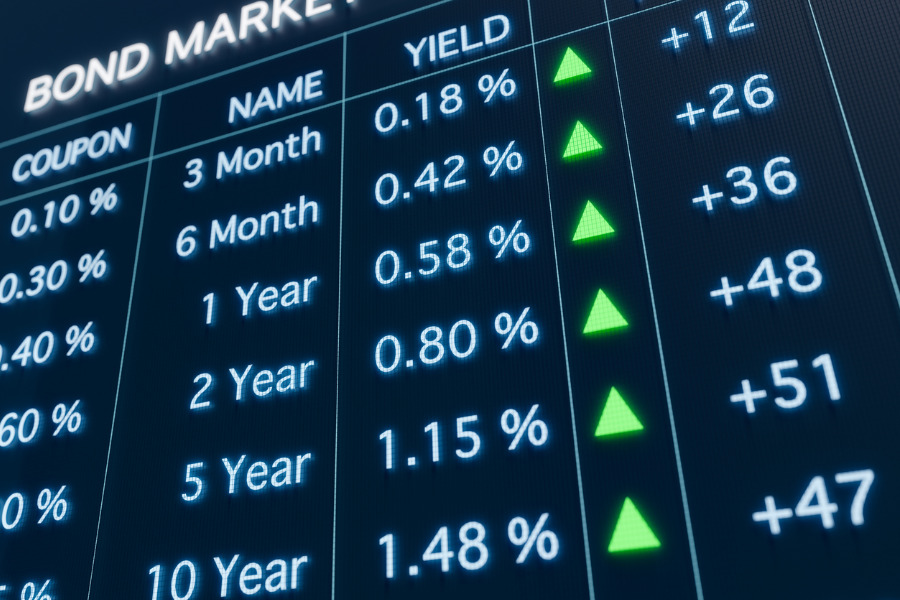

With Treasuries on track for their worst month this year, a hefty slate of auctions looms as a major test of whether yields have peaked after reaching the highest levels of 2024.
Investors are bracing for a tricky week, even beyond the risk of further volatility because of tensions in the Mideast. The market must absorb a combined $183 billion calendar of two-, five- and seven-year note sales — the first two of which will be at record levels. A crucial inflation reading at the end of the week that will then help shape expectations for the Federal Reserve’s path.
There’s already a strong indication that investors want to buy after yields surged this month on signs of a resilient economy, which led traders to push out bets on Fed interest-rate cuts to late 2024. The latest leg of the Treasuries sell-off briefly pushed the two-year rate above 5% after Fed Chair Jerome Powell signaled last week that the central bank is in no hurry to ease policy.
Now that 5% level looks like the magic number for bond managers seeking to put to money to work in short maturities. For Jack McIntyre at Brandywine Global Investment Management, the message from Powell reinforces the sense that a bottom may be in for Treasury prices.
“A Fed that sticks to their guns and says, ‘We are going to break inflation,’ means there’s a top in yields,” the portfolio manager said. “Yields will spike higher if the Fed backs off too soon and cuts.”
The two-year note ended last week at about 4.99%, so Tuesday’s auction has a chance to obtain a coupon of at least 5% on the maturity for the first time since last year. Before then, investors hadn’t seen such levels in more than a decade.
“A 5% coupon at the two-year auction is possible, we’re almost there,” said Michael Cudzil, a portfolio manager at Pacific Investment Management Co.
“The market has taken out a lot of cuts and it is reasonably priced at this point in time for a decent range of outcomes,” he said. Pimco has been adding more interest-rate exposure, with a preference for the front-end and the five- to seven-year area in Treasuries, he said.
Of course, there’s the risk that yields keep climbing across the curve toward the peaks of October, when yields on some maturities eclipsed 5%.
That’s where Friday’s report on the personal consumption expenditures price index, the Fed’s preferred inflation measure, comes in. The data is projected to show the annual rate rose to 2.6% last month, from 2.5% in February, which would suggest progress toward the Fed’s 2% goal has stalled. Traders are on notice after March consumer-price data came in hotter than forecast.
Still, there’s ample evidence of demand emerging. Last week’s 20-year auction, which brought yields at the second-highest level on record, was well received. And the latest client survey from JPMorgan Chase & Co. showed investors were net long on Treasuries by the most in several weeks.
Investors also have in mind that the return of a 5% two-year coupon last year presented a buying opportunity. The yield subsequently dipped below 4.15% in January as the market bet on rate cuts as early as March.
And while traders now expect the Fed to wait until the fourth quarter to cut, the likelihood of at least some easing this year suggests there’s scope for price appreciation in the new two- and five-year benchmarks.
“The two-year is attractive around 5%, despite being lower than bill yields and the stronger-than-expected CPI prints, as the Fed’s base case continues to be to cut rates,” said Priya Misra, a portfolio manager at J.P. Morgan Asset Management.
Bond investors see another potential source of demand for two-year notes at 5%: money market funds. The pile of cash in these funds tumbled in the last weekly data, dropping below $6 trillion, a move that was likely related to tax payments.
But as the two-year rate approaches bill yields that are currently closer to the Fed’s 5.25% to 5.5% range, retail investors may start to see the appeal of locking in these levels until 2026.
“The process of shifting from cash to some part of fixed income probably goes in stages and starts with a move into shorter maturities first,” said Brandywine’s McIntyre.

While industry statistics pointing to a succession crisis can cause alarm, advisor-owners should be free to consider a middle path between staying solo and catching the surging wave of M&A.

New joint research by T. Rowe Price, MIT, and Stanford University finds more diverse asset allocations among older participants.

With its asset pipeline bursting past $13 billion, Farther is looking to build more momentum with three new managing directors.

A Department of Labor proposal to scrap a regulatory provision under ERISA could create uncertainty for fiduciaries, the trade association argues.

"We continue to feel confident about our ability to capture 90%," LPL CEO Rich Steinmeier told analysts during the firm's 2nd quarter earnings call.
Orion's Tom Wilson on delivering coordinated, high-touch service in a world where returns alone no longer set you apart.
Barely a decade old, registered index-linked annuities have quickly surged in popularity, thanks to their unique blend of protection and growth potential—an appealing option for investors looking to chart a steadier course through today's choppy market waters, says Myles Lambert, Brighthouse Financial.
